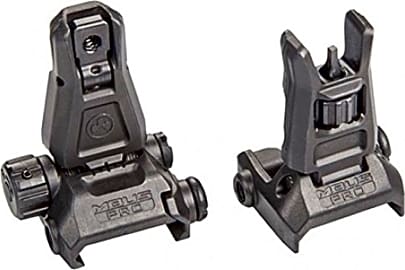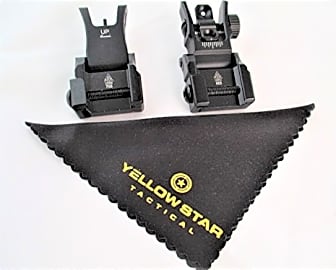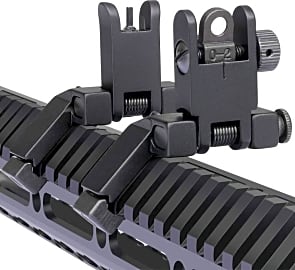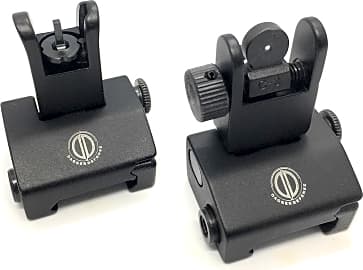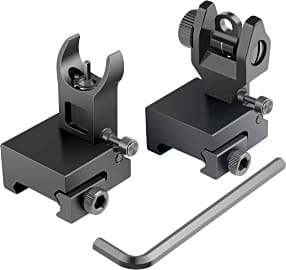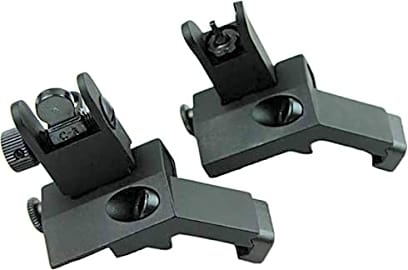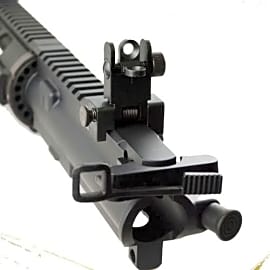The 10 Best Flip Up Sights

This wiki has been updated 35 times since it was first published in February of 2017. Whether you are a novice shooter or an experienced marksman, the best way to ensure an accurate shot is by using a reliable firearms sight. These flip-up models are there when you need them, but they can also conveniently and quickly fold down when you don't. They are ideal for shooters on the move, close-quarters targeting, and as a backup should your gun's primary optics fail. When users buy our independently chosen editorial picks, we may earn commissions to help fund the Wiki.
Editor's Notes
July 22, 2020:
Whether you are deploying in military missions or just out hunting with friends, backup iron sights are an important addition to your weapon. While we would all like to think our primary optics will never fail, this just isn't a reality. Scopes can break for a variety of reason, and if you don't have BUIS on your weapon, you may be left without an accurate way to aim when your life depends on it or a 12-point buck is within your grasp.
When it comes to durability, the Troy Industries Micro HK Style and Magpul MBUS Pro immediately stand out. Both of these companies are known for making flip-up sights that are built like a tank, and these models are no exception. The Micro HK Style have a basic design with no levers or springs to potentially break, while the Magpul MBUS Pro are made from a melonite-finished steel. Also from Magpul are the Magpul MBUS Generation 2. Though they are crafted from an impact-resistant polymer material, they are still impressively durable and have the added benefits of being very lightweight and completely impervious to rust or corrosion.
While all of these are designed to stay out of the way of your main optics when not in use, the Marmot 45 Degree Offset and Evans Unlimited 45 Degree present the least chance of causing any conflict due to their offset design. If rail space is an issue for you, these may be your best options. That being said, some may not like how they have to hold their rifle when using them.
If you need to balance affordability and quality, we recommend looking at the Ozark Armament Backup Battle, UTG Low Profile, and Dagger Defense Tactical BUIS. None of these command a lofty price tag, yet all feature reliable spring-loaded activation mechanisms, sturdy aluminum builds that can stand up to abuse in the field, and tend to hold their zero well. The Dagger Defense Tactical BUIS has the added benefit of coming from a Veteran-owned company, which we feel most consumers can appreciate.
September 05, 2019:
Flip up sights are generally considered back up devices to use when your main scope or aiming aid fails. That means you'll want them to be reliable, but also able to remain out of the way and barely noticeable when not in use. Because of this, we focused on finding models that were sturdy and held tight against the rail when folded down. However, we will be the first to admit that we made some sacrifices in these departments on a couple of the lower cost units, specifically the GRG Backup Iron Sight and Trinity Force Tactical, to ensure that even someone on the tightest of budgets could find something to fit their needs on our list.
If you fall firmly in the metal only club when it comes to BUIS, then you'll want to look at the Troy Industries Micro HK Style, Ozark Armament Battle, Magpul MBUS Pro, UTG Low Profile, and Evans Unlimited 45 Degree. Of these, the Troy Industries Micro HK Style and Magpul MBUS Pro come from the most-respected companies in the rifling community, though we think many people will be impressed by the quality-to-cost ratio of the UTG Low Profile and Ozark Armament Battle.
While it is easier to find durable and reliable metal models than polymer, we have identified a couple polymer BUIS that will impress even the most die-hard metal sight enthusiasts. The Magpul MBUS Generation II and Diamondhead USA Polymer can both easily last a lifetime and withstand rugged use in the field. Plus, they have the added benefit of being extremely lightweight and not susceptible to rust.
Special Honors
Bobro Engineering Lowrider BUIS Sight Set These aiming aids are ideal for short-barreled weapons or anyone who is looking to conserve space on their rail for other devices. They are sturdy and lightweight, and offer full elevation and windage adjustment, however they only have a single aperture in the rear sight. bobroengineering.com
ARMS 40L The ARMS 40L have a low-profile form that ensures they won't interfere with your main scope or other rail-mounted accessories. They are smartly designed to lean lightly to the rear, which allows them to fold in the correct direction if dropped and increasing their chances of maintaining their zero. armsmounts.com
A Brief History Of Sights
The past few centuries have seen numerous advances in sighting technology, especially in the field of scopes.
When firearms were first invented around the 14th century C.E., there was little need for any sort of aiming apparatus. This is because the weapons were so inaccurate, all you could do was point them in the general direction you wanted the bullets to go, and then hope for the best.
Once guns started becoming (slightly) more accurate a few centuries later, it became more imperative to have a way to ensure that your aim was true. The first sights were simply iron or brass beads mounted on the muzzle, with a fixed leaf attached to the rear. These didn't exactly allow for pinpoint accuracy, but at least you'd have a general idea of where your round would end up.
These front sights were screwed onto the barrel, and you could make windage adjustments by turning them in the proper direction. Many marksmen would scratch reference notches on the barrels, allowing for adjustments on the fly. They also began using rear sights of differing sizes that could be flicked into place to account for distance.
Meanwhile, in Germany in the 1500s, v-notched rear sights began to crop up. These were designed to focus the eye on the bead at the front of the rifle; soon, primitive tunnels were being made to further tighten this focus — the first scopes. This system became extremely popular in Denmark, and even crossed the pond into the Americas over the next few hundred years.
In 19th century Turkey, peep sights began being used. A series of peep holes were created in the rear sight, one on top of the other. This allowed shooters to use the proper sight hole for different distances, increasing accuracy. The design caught on across the Middle East, North Africa, and Europe, and in the latter country marksmen used only one hole, with the sight situated on a sliding ramp.
Eventually, an American named E.E. Patridge developed a flat pillar on the front sight, with a rectangular notch on the back end. Made wide enough to let light through, this allowed for shooters to adjust for windage on the fly, increasing accuracy without sacrificing speed. Patridge's system is still widely used on handguns and target-shooting firearms to this day.
The past few centuries have seen numerous advances in sighting technology, especially in the field of scopes. However, simple iron sights are still convenient and effective, especially for casual gun enthusiasts. While you may not feel like a sniper when peering through a flip-up sight, you will feel like a Wild West gunman...and isn't that much more fun?
Benefits Of Flip-Up Sights
Buying and attaching flip-up sights to your weapon may seem like overkill. But there are several reasons why you might want to consider altering your gun to support a second set of sights.
The great thing about flip-up sights is that they aren't in the way when not in use, so if you don't feel like using them, they won't interfere with your shooting experience.
The main reason is to act simply as a back-up in case your primary sights fail. This is especially important for cops, soldiers, or anyone else who carries in tactical situations where poor aim could prove fatal. Having a secondary system in place, especially one that's easy to implement without sacrificing accuracy, is a smart fail-safe.
Most quality flip-up sights allow for a variety of quick adjustments as well, including windage and distance. If your rifle doesn't have the best built-in sights, you can upgrade them without damaging the weapon. This can certainly come in handy for target shooters or other competitive marksmen.
The great thing about flip-up sights is that they aren't in the way when not in use, so if you don't feel like using them, they won't interfere with your shooting experience. They lay flat against the barrel, allowing you to use your primary sights until you need something with a little more precision.
Oh, and while this isn't the most compelling reason, they just look incredibly cool. That won't save your life in a pinch or improve your marksmanship, but shooting is supposed to be fun, remember? Might as well splurge on cool gear, like flip-up or red dot sights.
After all, it's not like anyone will take it away from you. You have a gun.
Other Gear To Consider
If you're considering adding secondary sights to your primary weapon, chances are you're serious about your shooting. If that's the case, there's some other gear you should consider to get the most out of your experience.
It's amazing how much of a difference a fun target can make, and it can take some of the drudgery out of your skill-building routine.
The first thing is a good rifle case. Not only will it protect your weapon, but it makes transporting it to and from the range a breeze. Most importantly, though, it can carry a ton of other gear, allowing you to spend even more on shooting supplies.
If you're serious about improving your accuracy, a quality bipod or bench rest is also important. You can only be so accurate when shooting from the shoulder (and it can even cause injuries), so finding a steady surface to support you is extremely important. After all, there's no point in investing in better sights if you're going to shoot haphazardly with them.
And, if you're hoping to maximize your fun, invest in some creative targets. There are options out there that allow you to play games (such as Battleship) during your practice rounds, while others let you pretend to take down an entire squad of evildoers. It's amazing how much of a difference a fun target can make, and it can take some of the drudgery out of your skill-building routine.
Of course, none of these things are strictly necessary, but they will help keep you organized and motivated — and they'll make the other shooters at the range jealous, which is half the fun anyway.



